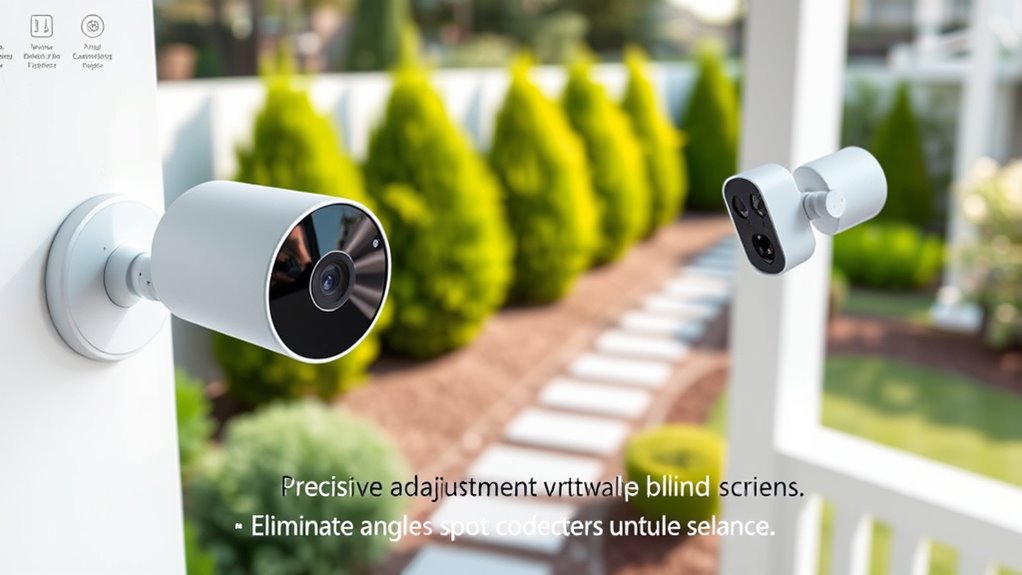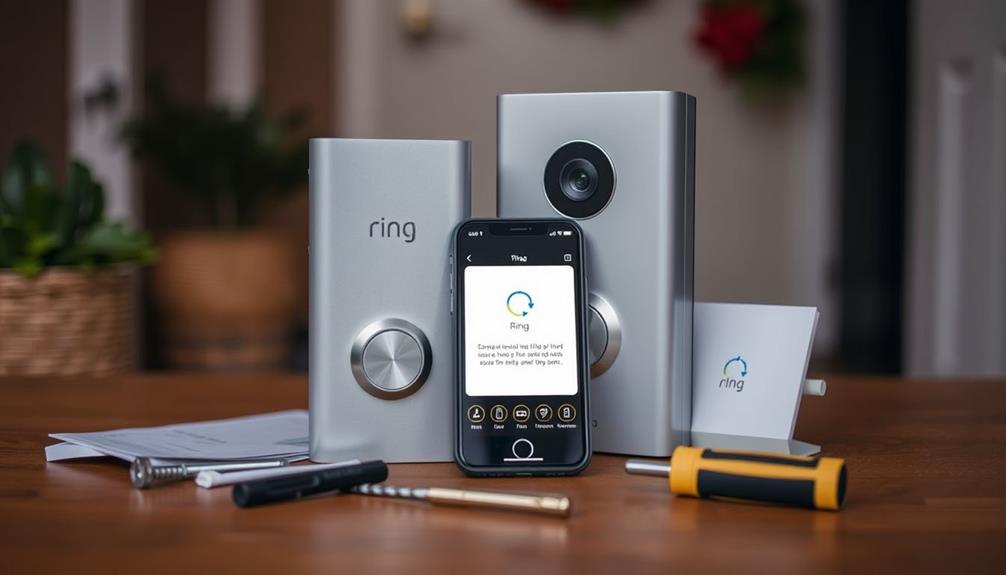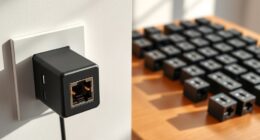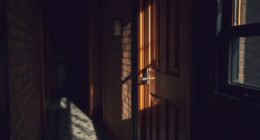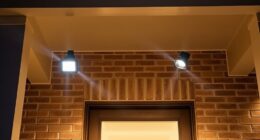To optimize your Ring camera angles and eliminate blind spots, assess vulnerable areas like entry points and high-traffic zones. Mount cameras higher for broad views and adjust tilts to cover key spots. Use accessories like adjustable mounts or extension arms to fine-tune angles, and guarantee overlapping views for continuous coverage. Regularly test and update angles based on lighting or weather changes. Keep learning how to improve your setup to stay secure and informed.
Key Takeaways
- Position cameras above entry points and at 8-10 feet for wide, unobstructed views.
- Use adjustable mounts and extension arms to fine-tune angles and cover hard-to-reach areas.
- Create overlapping camera views at key points to minimize blind spots and enhance detection accuracy.
- Regularly review footage and reangle cameras after weather events or seasonal foliage growth.
- Avoid direct sunlight and bright lights facing cameras to prevent glare and maintain clear night vision.
Assessing Your Home’s Vulnerable Areas

Before installing your Ring cameras, it’s essential to identify your home’s most vulnerable areas. Think about spots that intruders could access easily or where valuables are stored. Consider entry points like doors, windows, and side alleys. Be mindful of privacy concerns, especially if cameras face neighbors’ yards or public spaces. You want to enhance security without invading others’ privacy. Also, evaluate how your cameras will integrate with your existing security system. Proper assessment helps you avoid blind spots and ensures seamless security coverage. Take note of high-traffic zones and less-visible corners that might need extra attention. By thoroughly analyzing these vulnerabilities, you set a strong foundation for effective camera placement and better overall protection. Recognizing potential relationship conflicts and how they might manifest in your household can help in positioning cameras to monitor areas of concern more effectively.
Choosing the Optimal Camera Placement Spots

Once you’ve identified your home’s vulnerable areas, the next step is to select the best spots for your Ring cameras. Focus on camera height to ensure clear visibility and avoid obstructions. Position cameras higher on walls or eaves to minimize tampering while maintaining a wide view. Consider lighting conditions; place cameras where they’re not facing direct sunlight, which can cause glare, or areas with consistent lighting to capture clear images. Think about angles that cover entry points without blind spots. Here are some ideal placement ideas:
- Above front and back doors for quick access
- Corner mountings at 8-10 feet for maximum coverage
- Clear sightlines of driveways and walkways
- Areas with natural light for better image quality
- Avoid facing directly into bright lights or windows
- Experiment with unique twists in camera angles to stand out in a crowded security market.
Understanding the Camera’s Field of View and Limitations

Your ring camera’s viewing angle determines how much area it covers, but it also has limits you need to understand. Infrared technology helps at night, yet it doesn’t work perfectly in all conditions. Obstructions and blind spots can block your view, so recognizing these factors is key to optimizing your setup. Additionally, being aware of the camera’s field of view can help you position it more effectively to minimize blind spots.
Camera’s Viewing Angle
Understanding the camera’s field of view is essential for optimizing your Ring camera angles. Your camera’s viewing angle determines what it captures and what remains hidden. Keep in mind that lighting considerations can impact visibility, especially in low-light conditions, affecting how well your camera records details. Higher camera resolution enhances clarity, allowing you to see finer details within the field of view. When adjusting angles, imagine the scene:
- A wide, sweeping landscape of your yard
- The front porch with a clear path
- Shadows that obscure important details
- Overlapping coverage to eliminate blind spots
- The camera’s lens capturing both near and far objects
Being aware of camera limitations helps prevent blind spots and ensures comprehensive coverage.
Limitations of Infrared
Infrared technology allows your Ring camera to see in low-light conditions, but it has limitations that can affect your overall view. Infrared limitations often cause night vision challenges, especially in bright or reflective environments. The infrared LEDs may not illuminate distant objects clearly, leading to reduced image quality and potential blind spots. Additionally, understanding the Best Restaurants in your area can help you choose optimal outdoor dining spots that may be better lit or less reflective, improving overall visibility.
Obstructions and Blind Spots
Obstructions such as trees, fences, or parked vehicles can considerably limit your Ring camera’s field of view, creating blind spots that compromise security. These obstacles block clear visibility, especially during different lighting conditions or adverse weather effects, reducing the camera’s effectiveness. You might notice shadows cast by overgrown bushes or rain streaks blurring the lens, further restricting your view. Visualize these common obstructions:
- Overhanging tree branches swaying in the wind
- Fences blocking side entrances
- Vehicles parked directly in front of cameras
- Shrubs and bushes partially hiding key areas
- Poor lighting creating shadows or glare
Understanding how lighting conditions and weather effects influence your camera’s view helps you position it better, minimizing blind spots and keeping your property secure. Additionally, considering the field of view of your camera can help you select the optimal placement to cover the most area effectively.
Adjusting Camera Angles for Maximum Coverage

To achieve maximum coverage with your Ring camera, adjusting its angle is essential. Start by considering the lighting conditions; if an area is too bright or too dark, it can affect image clarity. Aim the camera where the lighting is balanced to ensure clear footage. Also, optimize the angle to match your camera resolution capabilities—higher resolution cameras capture more detail when properly aligned. Avoid pointing the camera directly at bright lights or windows that cause glare, which can obscure details. Instead, position the camera to cover entry points and high-traffic areas, adjusting the tilt and pan as needed. Regularly review footage to check for blind spots or glare, and fine-tune the angle for the best possible coverage. Incorporating artistic elements into your camera placement can also help blend it seamlessly into your home or outdoor decor while maintaining effective coverage.
Using Mounting Accessories to Enhance Viewing Angles

Using mounting accessories can substantially improve your Ring camera’s viewing angles beyond basic adjustments. Adjustable brackets allow you to tilt and swivel your camera for ideal coverage, reducing blind spots. With the right mounting accessories, you can position your camera higher or at unique angles that standard mounts can’t achieve. These accessories include flexible mounts, extension arms, and corner brackets that adapt to your specific space. Imagine:
Enhance your Ring camera’s view with flexible mounts and adjustable accessories for optimal security coverage.
- Extending your camera’s reach to cover wider areas
- Tilting downward to monitor doorsteps or driveways
- Mounting on uneven surfaces or angled walls
- Achieving better visibility over fences or shrubs
- Securing cameras at higher vantage points for a broader view
Investing in quality mounting accessories ensures your Ring camera captures every critical detail, maximizing security. Additionally, understanding the importance of camera positioning can help you optimize coverage and prevent blind spots effectively.
Incorporating Additional Cameras for Complete Surveillance

Adding more cameras to your setup guarantees thorough coverage of your property, leaving fewer blind spots and enhancing overall security. With additional cameras, you can strategically position them to maximize motion detection, ensuring alerts activate when activity occurs. Incorporate cameras with night vision to monitor your property effectively after dark, reducing vulnerabilities during nighttime hours. Placing cameras in key areas like entrances, driveways, and backyard perimeters creates overlapping views, which improves detection accuracy and reduces blind spots. By expanding your camera network, you gain an extensive surveillance system that offers continuous protection. Proper placement and the right features, such as motion detection and night vision, work together to keep your property secure around the clock. Understanding the AI Bifurcation can help you anticipate future technological developments that might influence surveillance strategies, ensuring your system remains adaptable and effective. This approach minimizes gaps and provides peace of mind.
Regularly Testing and Reconfiguring Camera Angles

Regularly testing and reconfiguring your camera angles keeps your surveillance system effective and responsive to changing conditions. By monitoring how lighting considerations shift throughout the day and adjusting angles accordingly, you prevent glare or shadows from creating blind spots. Weatherproofing strategies ensure your cameras remain functional during rain, snow, or wind, so re-evaluating their positioning becomes essential. Imagine:
- Checking for glare during bright sunlight hours
- Adjusting angles after heavy storms or snowfall
- Ensuring cameras aren’t obstructed by new foliage
- Confirming weatherproof seals are intact
- Reassessing angles as daylight hours change seasonally
Consistent testing helps you spot vulnerabilities and optimize coverage, maintaining security regardless of weather or lighting shifts. This proactive approach keeps your Ring system reliable and effective. Incorporating contrast ratio considerations ensures your cameras deliver clear images even in low-light or high-contrast conditions, further enhancing security.
Utilizing Ring’s App Features to Fine-Tune Camera Settings

The Ring app offers a range of features that allow you to precisely adjust your camera settings for ideal security. You can customize motion detection zones to focus on critical areas, reducing false alerts. Night vision settings let you enhance visibility in low light, ensuring clear footage after dark. To access these options, open the app and select your camera, then navigate to device settings. Use the table below to understand key features:
| Feature | Purpose | Adjustment Options |
|---|---|---|
| Motion Detection | Detects movement and triggers alerts | Sensitivity sliders, zones |
| Night Vision | Improves visibility in darkness | Auto, on, off, infrared mode |
| Alert Settings | Controls notification preferences | Sound, motion alerts |
| Camera Angle | Adjusts viewing direction | Live view, pan, tilt controls |
Fine-tuning these features ensures your camera covers blind spots and provides maximum security.
Frequently Asked Questions
How Often Should I Review and Adjust My Camera Angles?
You should review your camera placement and angle adjustments regularly to guarantee ideal coverage. Check your Ring cameras at least once a month, especially after weather changes or if you notice blind spots or unclear footage. Make small angle adjustments as needed to keep important areas in view. Regularly maintaining and tweaking your camera angles helps prevent blind spots and ensures you’re always capturing what matters most.
What Are Common Mistakes to Avoid When Positioning Cameras?
Did you know that improper camera placement causes over 40% of blind spots? When positioning your cameras, avoid common mistakes like setting camera height too high or too low, which can distort views. Focus on proper angle calibration, ensuring the lens covers entry points without obstructions. Keep the camera steady and test angles regularly. This helps you prevent gaps in your coverage and guarantees your security setup remains effective.
Can Weather Conditions Impact Camera Angle Effectiveness?
Weather impact can definitely affect your camera angle effectiveness. Rain, snow, or fog might obscure your view or cause reflections that distort images. Strong winds can shift the camera, requiring angle adjustment to maintain ideal coverage. Regularly check your camera’s positioning in various weather conditions and make necessary angle adjustments to ensure clear, reliable footage despite the weather. Staying proactive helps keep your surveillance effective and your property secure.
Are There Privacy Concerns With Multiple Camera Angles?
You might think multiple camera angles are purely for security, but they raise privacy risks and surveillance concerns. While they help cover blind spots, they can inadvertently record neighboring properties or public spaces, leading to privacy violations. It’s essential to balance security benefits with respect for others’ privacy rights. Regularly review camera placements and footage access to make certain you’re not infringing on privacy, avoiding unnecessary surveillance concerns.
How Do I Ensure Cameras Cover All Entry Points Effectively?
To guarantee your cameras cover all entry points effectively, position them strategically to maximize visibility. Use motion sensors to trigger alerts and focus camera angles on doorways and windows. Proper lighting placement also helps improve image clarity at night and deters intruders. Regularly check and adjust camera angles as needed, ensuring no blind spots remain. This proactive setup keeps your property secure and enhances overall surveillance coverage.
Conclusion
By perfectly optimizing your Ring camera angles, you’ll create an impenetrable fortress that no intruder can breach. Say goodbye to blind spots forever—your home will be so secure, even the sneakiest burglars won’t stand a chance! With the right adjustments, you’ll have surveillance so all-encompassing, it’s like having eyes in every corner. Get those cameras dialed in now, and transform your home into an invincible, watchful paradise!
